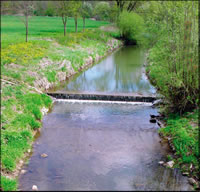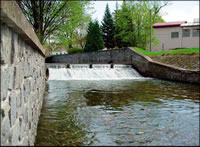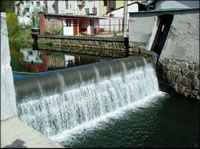 |
Some hurdles can be overcome -
if fish can jump... |
In May 2004 Hungary will, together with three other Danube Basin Countries,
become a member of the European Union. As a consequence, the country must
fulfil all the requirements of the EU Water Framework Directive, which -
unlike e.g. the Urban Wastewater Directive - does not allow a generous timeframe
for implementation. While the old member states had enough time to get familiar
with the new Directive during the 1996-2000 conciliation period, the accession
countries of 2004 did not enjoy the same privilege and might find this timeframe
particularly challenging. To remedy the situation, in November 2002 Hungary
launched a Twinning Project financed by EU-PHARE. For more than a year,
a team of mainly German experts led by Stephan von Keitz has been assisting
Hungary to prepare cost-effective systems for surface and groundwater monitoring.
Von Keitz and his team also provide assistance in institutional capacity
building and the fulfilment of reporting requirements.
 |
Some hurdles can be overcome -
if fish can jump... |
“To achieve these objectives, it was important to closely co-operate
with our Hungarian partners, such as the Ministry for Environment and Water,
the Budapest University of Technology and Economics, and the Water Resources
Research Centre VITUKI,” explains von Keitz. “In spite of Hungary's
long tradition and experience in monitoring the quality of rivers, lakes
and groundwater, there was still a need to adapt the existing monitoring
system to the European water legislation to get a modern, multifunctional,
flexible and costeffective water management tool,” von Keitz adds.
The newly developed strategy will serve for both the acquisition of monitoring
data and their management and reporting.
 |
But will any fish want
to participate in this Olympic event? |
A multi-step process
As a first step in translating the EU Water Framework Directive into national
regulation, it was necessary to assist Hungary in the development of a typology,
to delineate the country's surface and groundwater bodies and to decide
which of these water bodies are at risk. All these obligations have to be
reported to Brussels by March 2005.
Typology and reference conditions
Typology is important because it constitutes the basis for the description
of type-specific reference conditions and assessment tools, the designation
of water bodies, and the localisation of pressures and impacts, i.e. the
identification of the sensitivity of a particular surface water type to
different stressors. The Twinning Project team proposed that System B, used
in most EU member states, also be used in Hungary because it allows the
choice of additional parameters to the obligatory ones such as size, etc.,
and accurately reflects the reality by yielding biologically meaningful
types. Together with their Hungarian partners, the Twinning Project experts
developed a list of typologically relevant parameters (sub-eco-regions,
physical and chemical factors) and prepared a manual that enabled the Hungarian
experts to identify surface water types in Hungary. The development of a
strategy for the definition of reference conditions and the identification
of possible reference sites was discussed in two seminars on surface water
typology run by German experts. It will be realized during the prolongation
period.
Water body identification
The main objective of the WFD is to achieve a “good status”
in all water bodies. Therefore, the definition of each water body plays
an important role for all the next steps of the implementation period. In
terms of WFD environmental objectives all waters have to be delineated referring
to the category of water bodies. The German experts provided the Hungarian
partners with intricatenesses and obstacles, which had occurred while identifying
water bodies in Germany. Special emphasis was given to the fact that the
water bodies should have a reasonable size since this helps to reduce administrative
burdens. Since the delineation/ identification of all water bodies has to
take place by December 2004 and be reported to the Commission by March 2005,
it was a task of the Twinning Project team to provide assistance in the
identification of significant groundwater as well as surface water bodies
in Hungary. The first delineation led to a number of about 1000 water bodies.
These water bodies will now be grouped to reduce their number. Furthermore
the HMWB will be identified according to the CIS-approach. Since Hungary
borders on as many as seven countries, special consideration was given to
transboundary water bodies.
Analysis of the pressures and impacts
For the ImPress analysis, criteria were composed to identify human activities
as pressures and impacts that put the Directives’ environmental objectives
at risk. These lists put special emphasis on existing information, potentials
of data flow and available capacities. The demonstration of these undertakings
on the basis of case studies will lead to an identification of water bodies
at risk. The detailed German criteria for given situations proved the principal
applicability for Hungary.
Since the accessible biological data have proved to be insufficient, abiotic
data will be used preliminarily. In the months to come, the Twinning Project
team will make the finalization of this work its priority.
WFD implementation handbook
In order to facilitate a uniform and smooth approach of the WFD implementation
in Hungary within the Directives’ tight deadlines, the Twinning Project
team developed a WFD implementation handbook. This guidance document is
designed as a tool for water managers to implement the WFD on national and
regional level. It addresses all information that needs to be collected
on a product basis and has the character of a loose-leaf compilation. The
first edition gives special regard to activities, which have to be completed
within the first four years of the implementation period. The guidance document
takes the findings of the CIS Working Groups, the German LAWA Guide as well
as recommendations of the ICPDR on the implementation of the WFD into consideration
and will be continuously updated.
Product ready for Hungary - and Brussels
As a result of all these joint efforts, Hungary today has a developed typology
exhibiting 20 stream types. This simple but meaningful typology is fully
in accordance with the requirements of WFD. The surface and groundwater
bodies are identified and their risk of failing to achieve the “good
status” quality objective will soon be identified. In addition, the
Project includes two service contracts with a total amount of euro 2,7m,
which will enable Hungary to carry out biological and chemical assessment
in accordance with the WFD requirements.
For further information:
www.eu-wfd.info